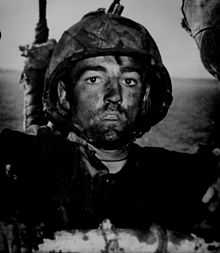Battle of Eniwetok
| Battle of Eniwetok | |||||||
|---|---|---|---|---|---|---|---|
| Part of World War II, Pacific War | |||||||
 Landing craft heading for Eniwetok Island on 19 February 1944 | |||||||
| |||||||
| Belligerents | |||||||
|
|
| ||||||
| Commanders and leaders | |||||||
|
|
| ||||||
| Strength | |||||||
| 2 regiments | 3,500[1]:32 | ||||||
| Casualties and losses | |||||||
|
313 killed 77 missing 879 wounded[1]:88 |
3,380 killed 105 captured[1]:88 | ||||||
The Battle of Eniwetok was a battle of the Pacific campaign of World War II, fought between 17 February 1944 and 23 February 1944, on Eniwetok Atoll in the Marshall Islands.
Background
The invasion of Eniwetok followed the American success in the Battle of Kwajalein to the southeast. Capture of Eniwetok would provide an airfield and harbour to support attacks on the Mariana Islands to the northwest.
In 1943 the Japanese established light defenses at Eniwetok—they believed that the Americans would strike at the southwestern Marshalls first. The 1st Amphibious Brigade reinforced the defenders in January 1944; its commander, Major General Yoshimi Nishida[1]:32 along with a tank Company, led by First Lieutenant Ichikawa (9 Type 95 Light Tanks). The 1st Amphibious began to construct defenses, but repeated air attacks made this difficult, and the tiny coral islands meant that defense in depth would be impossible.
Vice Admiral Raymond Spruance preceded the invasion by Operation Hailstone, a carrier strike against the Japanese base at Truk in the Caroline Islands.[1]:67 This raid destroyed 39 warships and more than 200 planes.[1]:67
Battle

Naval bombardment of Eniwetok began on 17 February, and the 22nd Marine Regiment, commanded by Col John T. Walker, landed on Engebi Island, on 18 February at 08:43 the next day.[1]:69-70 Resistance was light, and the island was declared secure by 1450, though mopping-up continued through the next day.[1]:70 US losses included 85 dead and missing plus 166 wounded.[1]:73
Intelligence suggested that the defenses on Eniwetok Island would be heavier than planned, though there was a comparatively heavy preparatory bombardment before the 1st and 3rd Battalions of the 106th Infantry Regiment went ashore at 0916 on 19 Feb., followed by the 3/22 at 1425.[1]:77 However, the Japanese soldiers had strong spider-hole positions, plus the Japanese concentrated their forces to the southwest, counterattacking the American flank, which forced the Americans to attack through the night.[1]:78 The island was not secured until 21 February.[1]:78 37 Americans were killed or missing and 94 wounded.[1]:78
The mistake was not repeated at Parry Island. The battleships USS Tennessee and USS Pennsylvania and other ships delivered more than 900 tons of explosive onto the island. The 104th Field Artillery on Eniwetok and the 2nd Separate Pack Howitzer Battalions on Japtan provided additional fire support.[1]:79 The 1/22 and 2/22 Marines landed at 0900 on 22 Feb.[1]:80-81 At 1930, the regimental commander radioed "I present you with the island of Parry", though operations continued through the next day.[1]:83-85 US casualties included 73 dead and missing plus 261 wounded.[1]:83
Aftermath

Eniwetok Atoll provided a forward base for the United States Navy for its later operations.
Notes
References
- Morison, Samuel Eliot (1961). Aleutians, Gilberts and Marshalls, June 1942-April 1944, History of United States Naval Operations in World War II. Boston: Little, Brown and Company. ASIN B0007FBB8I.
- Rottman, Gordon; Howard Gerrard (2004). The Marshall Islands 1944: "Operation Flintlock, the capture of Kwajalein and Eniwetok". Osprey Publishing. ISBN 1-84176-851-0.
- Rottman, Gordon; Dr Duncan Anderson (2004). US Marine Corps Pacific Theater of Operations 1943-44. Osprey Publishing. ISBN 1-84176-651-8.
Further reading
- Eastern Mandates. US Army Campaigns in World War II. United States Army Center of Military History. CMH Pub 72-23.
- Breaking the Outer Ring: Marine Landings in the Marshall Islands
- Heinl, Robert D., and John A. Crown (1954). "The Marshalls: Increasing the Tempo". USMC Historical Monograph. Historical Division, Division of Public Information, Headquarters U.S. Marine Corps. Archived from the original on 16 November 2006. Retrieved 2006-12-04.
- Dyer, George Carroll (1956). "The Amphibians Came to Conquer: The Story of Admiral Richmond Kelly Turner". United States Government Printing Office. Archived from the original on 21 May 2011. Retrieved May 5, 2011.
External links
| Wikimedia Commons has media related to Battle of Eniwetok. |